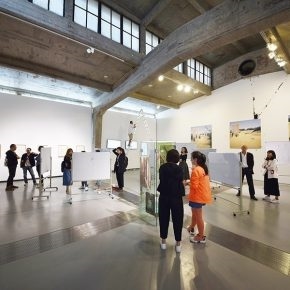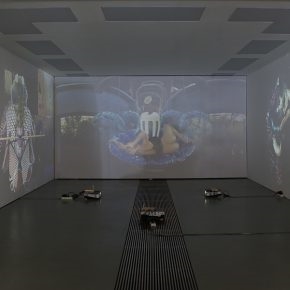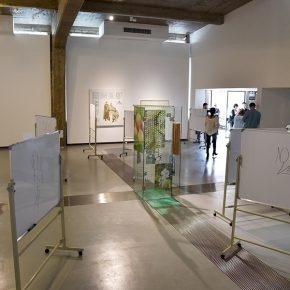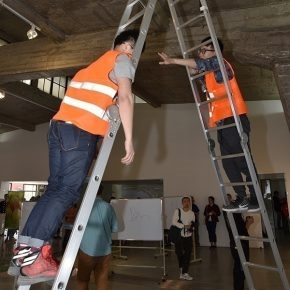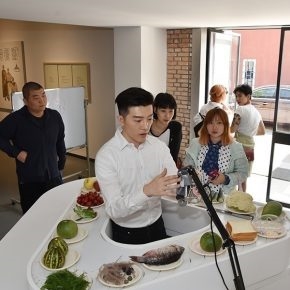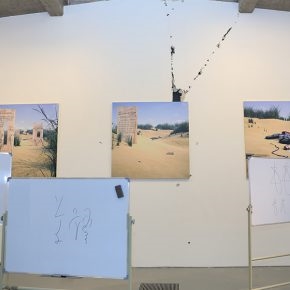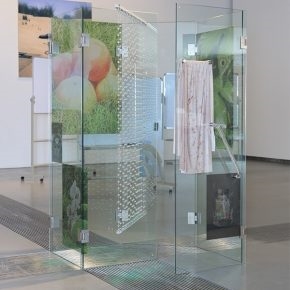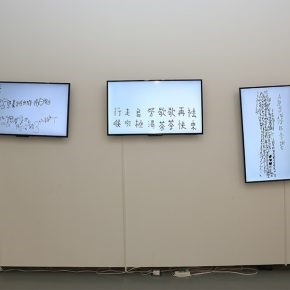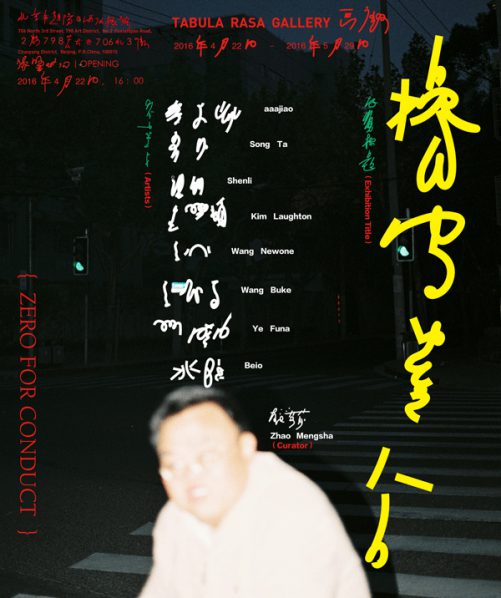
Zero for Conduct
By Zhao Mengsha
Since the word “future” entered exhibition titles and news headlines, people in the art world started to feel anxious about their next exhibition, instead of what’s for lunch. We always ex-pect too much creativity from artists; however, the over-consumption of “newness” and the unconditional embrace of crossovers with broader fields are in fact proof of the creative ener-gy deteriorating inside. Media and the exhibition cycle only exacerbate the anxiety. It appears that the whole art world is going through a slow phase, all we see are “bad students”.
The freedom and instant nature of sharing information changed the cognitive behavior of a generation. The strong thirst for knowledge and anxiety for being unique, are disappearing; Therefore, we expect a clear and effective discussion on behavior of time creation. Hereon, Zero For Conduct is neither a test nor a judgment. I want to appropriate the name of Jean Vi-go’s movie to intimate an interaction between individual and system; at the same time, providing a response to the so called “attention economy”. When the self-creation of pio-neers begins to normalize, verging into banality, how should we look at the end of subjectiv-ity in art?
The cross-over between dance, body performance and visual art has become a classic way to collaborate. In “Peep Stream”, live performance evolves into an instant “watching-performing” loop. Under the framework of “exhibitionism”, a breakthrough of time space is achieved by live streaming on the Internet, subconscious act is revealed and intersected inside different “windows”, thus fundamentally changing the binary distinction between real life and performance.
Shenli is an architect and an active blogger on Tumblr. His photography is based on the in-vestigation of material and space. Proposing a discussion of “superflat” in three-dimensional space, Shenli has found a solution in photography: By using one material to mimic the other, under a specific lighting, the physicality of object has been transformed.
Kim Laughton is an artist living in Shanghai. To him, language is an estrangement of infor-mation, the unreadable Chinese characters become a visual element, which attracts him. Like some kind of ambiguous graffiti, they act like symbols in his images. Kim Laughton is ob-sessed with the abstraction and malleability of of images. He scanned all sorts of parapherna-lia from his daily life, recombined them on a computer and then rendered them in lifelike 3D.
Wang Newone is obsessed with building super realistic scenario in video works. The deli-cately designed figures look like characters in a video game. Their actions are absurd, pre-tending to do things against a backdrop of unrealistic objects coming and going. Artificial sound effects sometimes appear to interact with the imagery sometimes not, creating a virtual space based in reality. Aided by computer imaging, different materials came together to rep-resent a virtual but appreciable reality.
In comparison to the embrace of technology in Kim Laughton and Wang Newone’s works, aaajiao ‘s creation is more like a nostalgic discussion of the death of pre-internet era or a re-examination of the fast evolving technology. Tennis for none found a rhythmic aesthetics in one of the earliest computer games. In When a website dies, a ghost like hands moving unin-tentionally. In some respect, the way these information appear to us is like ancient civilization to digital images, algorithm to AI, are all elegy of now expressed in future tense.
With the advent of Pinyin input method, the action of writing down words has been trans-formed to a movement of fingers. Song Ta decides to pick up the discarded intermediary – pen, to figure out the meaning of handwriting today. The artist has researched the composi-tion, methods and strokes of traditional Chinese calligraphy, taking account of contemporary practices of calligraphers in China, Japan and South Korea, as well as combining lessons from graphic designs and typography, all in the service of creating a new system of making callig-raphy. Song Ta’s work, Gel Pen, calligraphy in the age of Mark Twain denies the cultural and social symbols of calligraphy, and promotes a democratization of the art form with an open attitude, cunningly escapes the constraint of the scholastic calligraphic tradition.
Writing and dreaming take us away from our screens. Reading and looking create a channel for sensory experience in Wang Buke’s works. The wisdom of others form the base layer of his works. By a method akin to self-psychoanalysis, he creates the color of his dreams, trans-lating knowledge and experience to a visual presentation. Transient and subtle feelings, or uncategorizable sensory experience and expressed in an easily relatable way.
In making this exhibition, I, the curator whose day job is a critic gets close and personal with the subject of my research. My method of evaluating art changes from the analytical, the sub-jective, ex post facto to one that is closely involved with the creative process. Curating moves a critic’s point of view closer to that of the artist.
Writing is speech curtailed. Likewise, curators ought to stop before reaching a conclusion, yielding more space for the viewer to think. If every exhibition is a timed examination for the curator, this time, we are risking getting zero for conduct. Much remains unsaid.
About the exhibition
Date: April 22, 2016 – May 29, 2016
Venue: Tabula Rasa Gallery
Artists: Bei Ou, Kim Laughton, Shen Li, Song Ta, Wang Xinyi, Wang Buke, Xu Wenkai, Ye Funa
Courtesy of the artists and Tabula Rasa Gallery.


